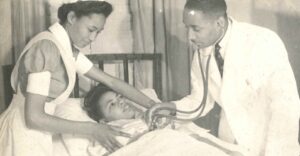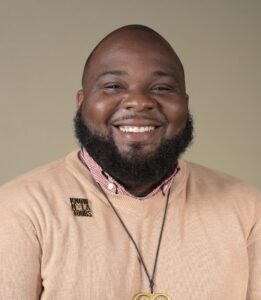
The Dillard University Archives and Special Collections is housed on the second floor of the Will W. Alexander Library. The Dillard University Archives & Special Collections (DUASC) serves as the official institutional memory of Dillard University and as the official repository for the documents of Straight College, New Orleans University, Gilbert Academy, Flint Goodridge Hospital, and Dillard University.
DUASC houses university documents, photographs, yearbooks, catalogs, departmental records, presidential records, board of trustees records, campus programs, campus publications, and other significant university documents. DUASC also maintains a collection of rare books, maps, manuscripts, and physical items connected to the experience of African Americans and the city of New Orleans.


Will W. Alexander Papers – William Winton Alexander was a pivotal figure in race relations and poverty support. He was a key component to the founding of the Commission on Interracial Cooperation in 1919. Alexander also headed the Farm Security Administration from 1937 to 1940 and then became vice-president of the Rosenwald Fund from 1940 to 1948. Throughout the 1940’s and 1950’s, he worked with the Edgar Stern Family Fund and in international relations. He also served as acting President of Dillard University from 1935-36. This collection is made up of three series containing Mr. Alexander’s works: writings, speeches, addresses, lectures, reports, and administrative records. Its extent is 2.5 linear ft.
Clara Blanchet Collection – This collection contains three series. These series are important due to Straight University’s significance amongst African Americans, and what they would eventually accomplish due to a new education. Series are primarily comprised of materials centered on Straight University: Straight University photographs, programs, booklets, catalogs, student information, and meeting minutes. Extent is .5 linear foot.
Cook Family Collection – Cook’s experiences include teaching positions at Atlanta University, Duke University, and UCLA. Between 1953 and 1955, Cook served as Social Sciences Specialist to the U.S. Army. In 1975, Dr. Cook became President of Dillard University. At Dillard, Cook was responsible for increasing enrollment, instituting a Japanese Studies program and a Center for Black Jewish Relations. His writings include articles on Martin Luther King Jr. and the black revolution and political movements in the South. Cook’s affiliations included the Southern Political Science Association, editorial board of the Journal of Negro History and Pi Sigma Alpha. This collection is composed of nine series which subjects include: photographs, programs, newspaper clippings, monograph and serial publications and writings. Extent is 1 linear foot.
David J. Malarcher Collection – A student of New Orleans University, Malarcher would begin his famed baseball career. Malarcher baseball career is varied over a few years with multiple teams, which included: Indianapolis ABCs, Detroit Stars and the Chicago American Giants. Within nine years leading the American Giants, Malarcher saw six playoff appearances, and two Negro League World Series championships. This collection gives a better insight into Mr. Malarcher’s poetic talents not just his baseball career. It is comprised of five series that include: poems, player contracts, correspondence, photographs, and articles. Extent is .5 linear foot.
Dent Family Collection – The Dent Family collection contains extensive material on Albert W. Dent, Jessie Covington Dent, and their son, Tom Dent. For six years Mr. Dent worked as superintendent of Flint-Goodridge Hospital, as well as, business manager for Dillard University. From 1941 – 1969, Albert Dent was Dillard University’s President. Tom Dent is a noteworthy Freedom Writer, where his writing began while working for the Houston Informer and the New York Age. He became a public information worker for the NAACP Legal Defense and Educational Fund in 1961. Heavy involvement in the Civil Rights Movement and the significance of its struggle was reflected greatly within Tom’s writings. The Dent Family Collection contains three series, each dedicated to the respected Dents. The details of the collection consist of: school publications, writings and addresses, programs, correspondence, collected articles, collected publications, dedications, newspaper clippings, and flyers. The extent is 1 linear foot.
Lucile L. Hutton Collection – Hutton is a product of Straight College’s Normal Department. She taught in the New Orleans Public Schools immediately after her graduation. Ms. Hutton was a very versatile individual, earning a Music degree from Oberlin and a Master’s in Music from Northwestern University. Her collection is composed of three series made up of: programs, constitutions and by-laws, publications and correspondence. The highlight of the collection include an 1895 copy of Alice Ruth Moore’s Violets and Other Tales with handwritten notes on the author by Ms. Hutton and a history of the United Church of Christ. Extent is .5 linear foot.
George E. Haynes Collection – George E. Haynes was a devoted sociologist, race relations expert, and Urban League founder. The collection consists of seven series mostly: writings produced in the 1930s and 1940s, awards, biographical information, correspondence, and a collection of writings by W. Montague Cobb’s (the First African American to receive a Ph.D. in Anthropology). Extent is 1 linear foot.
Gilbert D. Fletcher Collection – Mr. Fletcher is a Dillard University graduate, whom over time organized art activities for preschool children as a teacher and was an art editor for R. R. Bowker Company in New York. Mr. Fletcher’s paintings have appeared in published poems. The collection contains works ranging from the 1970s to the 1980s. The collection is composed of seven series featuring: announcements, invitations and programs, awards, as well as correspondence. The extent of the collection is 1 linear foot.
James Hardy Dillard Collection – Mr. Dent is the philanthropist whom Dillard University is named after. While working with the New Orleans Public Library, Child Welfare Association, and the Louisiana State Board of Education, Mr. Dillard was able to drastically improve race relations and education opportunities for African Americans. He was the first president and director of the Negro Rural School Fund. The collection is comprised of Mr. Dillard’s own materials and materials written about him. This is a five series collection composed of: articles, addresses, and a report of the Phelps-Strokes Fund (A non-profit fund catering to African and African American causes), photographs, newspaper clippings and biographical information. The extent is 1 linear foot.
Stern Family Collection – A philanthropist and business man, who was made planning chairman of a drive to raise funds to merge two African American schools, Straight College and New Orleans University, which gave birth to Dillard University. He became the first president of its board. The Stern Collection is composed of six series: materials regarding Stern and his wife, letters, correspondence, articles, programs, memos, photographs, sound recordings, a catalog of the Longview Foundation’s Arts Program, newspaper clippings, a copy of, “A Survey for the Educational Facilities” and resources of Orleans Parish, a picture album of President Johnson and his family. The extent is 1 linear foot.
George Longe Collection – George Longe was an educator and one who devoted himself to community service in New Orleans. He served as a principal for many New Orleans schools and was involved greatly in New Orleans’ groups focused on racial and community improvement. The collection is arranged into three series featuring: public school materials, organizations, associations, photos, booklets, and requisitions. The extent is 1.5 linear feet.
Sylvia Fannie Murray Collection – This collection provides a window into an active young woman’s life. She participated in school events, community social clubs and Carnival. The collection is composed of four series containing: programs, calendars, invitations, photographs, newsletters, news clippings, cards, poems, and a painting. The extent is .5 linear foot.
McPherson Freedom Collection – The collection mainly consists of abolitionist literature spanning from 1769 to 1864. Highlights of the collection include pamphlets published by the Loyal Publication Society, minutes of the proceedings of abolition societies and an original letter to Thomas W. Higginson, co-organizer of the 1857 Disunion Convention. The extent of the collection is .5 linear foot.
Julius Rosenwald Fund Collection – This focuses on a fund established by philanthropist Julius Rosenwald in 1917. This fund provided an incredible financial contribution toward improvements in African American health, education, and welfare. It was concentrated in the South where it developed education initiatives for African Americans, schools, libraries, and improvements in race relations. The collection is made of four series containing: publications, reports, agendas, correspondence, articles, poems, and a memorandum. The extent is 1.5 linear feet.
The Straight College Collection – Straight College was founded as Straight University in 1868, a predecessor to Dillard University, where it served as a symbol of African American advancement in the South, and throughout the post-Civil War era. It offered studies in elementary level education to college level, music, law, and Normal classes. The Straight College Collection is comprised of seven series featuring: university publications, programs, scrapbooks, photographs and diplomas. The extent of the collection is 7 linear feet.
New Orleans University Collection – New Orleans University began operation in 1873. Like Straight College, New Orleans University serves as a symbol of African American advancement and higher education during a time African Americans were seeking to become literate. New Orleans University merged with Straight College, and formed Dillard University. The New Orleans University Collection consists of five series featuring: university publications, programs, photographs, and diplomas. The extent of the collection is 2.5 linear feet.
Gilbert Academy Collection – Gilbert Academy received its name from William L. Gilbert, a farmer and businessman who contributed to the education and welfare of African Americans in the South. Gilbert Academy began with the Colored Orphan’s Home located on plantation lands of Bayou Teche, which was established by the Freedman’s Bureau. The orphanage housed orphan children of African American Union Soldiers. Gilbert Academy is the culmination of this orphanage and a preparatory school called La Teche Seminary. From 1935 to 1949, the Academy served as a diverse co-ed private high school for African Americans in New Orleans. The Academy was reinstated in 2000, as Dillard University past President Michael Lomax sought to create a summer enrichment programs for high school students seeking a college education. The extent of the collection is 1.5 linear feet.
.
© 2024 – All Rights Reserved